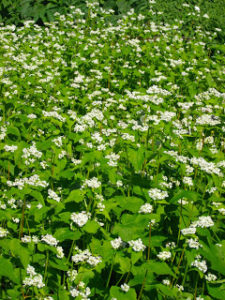
Photo of buckwheat cover crop, courtesy of Al Pasternak.
Cover crops are generally used in winter, or less optimal growing seasons (early to late fall). Planting a cover crop is a good choice if you find that you are too busy to garden over the fall/winter months or if you want to prepare your garden for production in the spring by providing it with nutrients.
Cover crops have many benefits; they include: increased soil fertility, increased nutrient levels (particularly nitrogen), suppressed weeds, pest and disease control, and best of all, reduced water use. They are typically fast growing crops of legumes, grasses or grains. Additionally, they provide a stable root system which reduces soil erosion from winter rains.
Planting a cover crop is easy. Simply pull all of the existing plants and weeds in your plot (Tip: make sure you pull weeds gently or you will shake seeds loose). Once your plot is clear, you can sprinkle several of your cover crop seeds over the planting area. At this point, you can add a thin layer of compost or potting soil. The planting density can be as thin or thick as you would like; cover crops will thrive under most density conditions (see the picture of buckwheat above for an example of density). Water your plot thoroughly and let it rest. Cover crops will require water early on in their growing cycle to establish their root systems.
Some common cover crops are buckwheat (pictured above), clover, sorghum, barley and winter wheat. Check out your local landscape center or nursery to see which varieties are available. A note of caution, some cover crops are perennials which means that they will need to be pulled at the end of the season. So make sure you purchase an annual plant type, which will die back at the end of the season.
For further reading see: http://en.wikipedia.org/wiki/Cover_crop and http://www.omafra.gov.on.ca/english/crops/facts/cover_crops01/cover_types.htm
